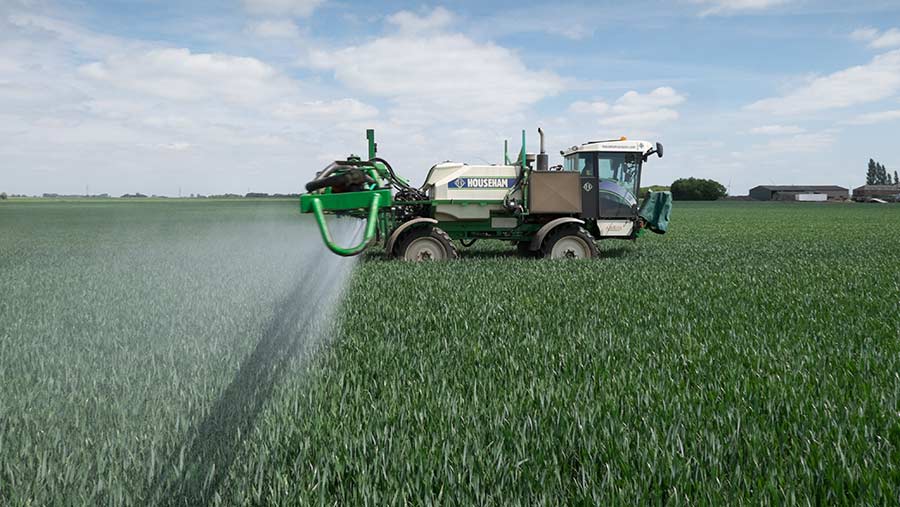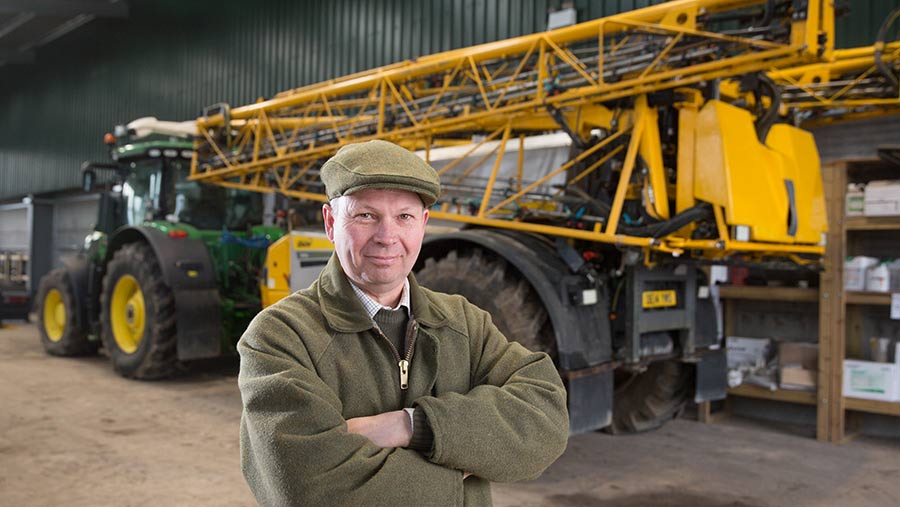How a farmer cut fungicide with variable-rate applications
 © Tim Scrivener
© Tim Scrivener Savings in fungicide and plant growth regulator of up to 25% have been made since Oxfordshire farming business Ben Smith & Sons introduced variable-rate spray applications.
After four seasons, that translates to a 10-15% reduction across the winter wheat and spring barley acreage, with some seasonal fluctuations according to growing conditions.
See also: A grower’s guide to buying a drone
This approach is now an integral part of the farming system, and the business is also using variable application of fertilisers and seed rates, so that all inputs are targeted according to need and crops are being given every chance of meeting their full potential.
Using existing technology
Four years ago, it was an obvious progression for the 2,020ha arable business to change the way fungicide and plant growth regulator (PGR) sprays were applied, as the farm was already equipped for the move.
“We were three parts of the way there,” explains Mr Smith. “We use liquid fertiliser, so we had our own Yara N-Sensor already connected to the sprayer for our nitrogen applications and the technology was working well for us. There was nothing to stop us giving it a go.”

© Tim Scrivener
The principles are much the same as they are for nitrogen, with measurements of the crop’s light reflectance and biomass being made by the tractor-mounted sensor as it moves through the field.
Using the N-Sensor in the late protein dressing mode reverses the way it works – so instead of putting more on the poorer areas and less on the good parts, it allows thicker areas of crop to receive a higher rate of fungicide and PGR than the sparser areas, which get less.
Reduction in spray bill
To date, Mr Smith has varied fungicide use on winter wheat and spring barley with considerable success at Manor Road Farm, Wantage, seeing a fall in his agrochemicals bill and a slight increase in yields. He hasn’t used the technique on oilseed rape.
With cereals, Mr Smith’s experience suggests it works best at the earlier spray timings, specifically the T1 slot. “That’s where it has made the biggest difference. The T0 timing can be a bit early, as the crop can still be very small.”
By T2 and T3, his cereal crops have been evened up by the N-Sensor varying fertilisers, so the effect is less obvious. “It’s also more appropriate to vary rates with protectant products. If you need curative activity for whatever reason, you need to careful about cutting back.”
He operates one trailed sprayer across the 2,020ha, applying all the farm’s fertiliser and sprays with it. His PGR use has come down, with crops standing better than before, as has his fungicide use in most seasons.
“As every farmer knows, the conditions and the type of season has a major effect on pesticide use. We have learned to trust the technology, rather than just deciding to cut back because it has been dry or to increase rates because the weather favours disease.”
Herbicide dilemma
However, Mr Smith hasn’t used variable rate herbicides yet and is reluctant to do so. “I’m not sure we would get a good enough kill of the weeds where a reduced rate was being applied.
“There could also be some tank-mix implications where herbicides and fungicides were going on at the same time. You have to decide between saving a pass by having the herbicide in the tank and not varying the application, or leaving the herbicide out.”
An alternative is to include the herbicide with a later fungicide timing, when the rate isn’t varied as much, he suggests.
In terms of his other variable-rate inputs, Mr Smith says that he is saving on phosphorus and potassium fertiliser, but not on nitrogen. “We are using the same amount, but targeting it better.
“With seed, we are using a bit more. We have an enormous range of soil types and various pest problems, so seed rates have gone up rather than down. We also use more where we have blackgrass.”
The ‘dark art’ of variable fungicides
The technology is ready but, when it comes to using variable-rate fungicides, there is still some way to go with the pathology, says independent precision farming expert Clive Blacker, of Precision Decisions.
“The kit is not the limitation. It’s the agronomy advice and understanding that holds people back.”
As most agronomists aren’t certain about the optimum amount of active ingredient for each unit of green leaf area, they tend to go for blanket applications regardless of the canopy size, he explains.
“That knowledge gap is the current issue. There’s also a fear factor – for some, the risk of not doing it right is greater than the benefits that it can offer.”
The grower’s attitude to risk is another consideration, with some being happy to take the risk and save money on inputs, says Mr Blacker. “The reward is the saving can be as much as 30%. Others aren’t risk-takers and won’t do anything that may compromise the final disease control result.”
Where protectant products are being used, there is more scope to vary rates, he believes. “It works better where you are aiming to protect an area of leaf and you can spray before disease takes hold. If disease is already established and you need to be sure of eradicant activity, it isn’t so appropriate.”
It’s important to decide whether the justification for varying a fungicide is the amount of disease present or the leaf area, continues Mr Blacker.
“With septoria, for example, there may be more opportunity for water splash to spread the disease in a thinner crop area, but leaf rub could readily transfer the disease in a thicker patch. So agronomic understanding has a role.”
Variable-rate plant growth regulators (PGRs) are easier to apply, and are less risky, he suggests. “PGR use ties in with nitrogen use. Trials have shown a 3-3.5% yield response to variable-rate nitrogen applications and a 2-3% response to PGRs. But when they are both applied variably, there has been a 7-8% yield response.”
Looking ahead, there is work being done to identify disease spectrally, as well as investigation of devices that can give advance warning of diseases.
“Spectral identification doesn’t tell you what the disease is or how much is there yet. The use of spore sensors may give you a better idea of what’s likely to occur in the field, so that information can be included in any spray strategy.”

